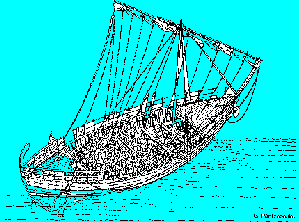
WAS THE SHIP THE VICTIM OF A PIRATICAL ATTACK?
"We haven't found yet any real traces of personal belongings in the wreck. What happened to the crew? What was the fate of the captain and his purse, which was so necessary for him during this commercial trip? Most of the seven rusty coins that have been discovered were found in the nets, on deck. Even though they were worth a few drachmas for the ancients, today these coins are invaluable because they help us to date the ship between 310 and 300 B.C.
There were no heavy goods included in the cargo, which was probably loaded on the bow. According to our investigations, without this the ship would have been overloaded at the bow and unsuitable for a voyage.
So we asked ourselves: Where were the captain and the sailors' personal effects? Were the seamen rescued by clinging to the mast or anything else during the storm? This was our first guess, considering what we learnt from dating organic remnants. Experiments proved that the trees that were used in building the Kyrenia ship had been cut down in 389 B.C, i.e 101 years earlier, which gives the impression that the ship had been repaired several times and sheathed on the outside with lead before sinking due to old age.
New mysterious signs ;
We thought that we had irrefutable evidence in our hands until we came across some unexpected clues
during our studies a few years ago. ;
During our investigations we found pieces of iron on various parts of the seabed. When these items had been cleaned, we found out that they were actually eight spearheads, which lay underneath the ship, and that some of them showed traces of lead that coated the ship.
What was the significance of this? Did the ship go down during a naval battle? This seemed to be a remote possibility considering the enormity of the Mediterranean sea.
This led us to some other speculation about the construction of the spears. Irrespective of whether the spears had been made for use on land or sea, they had a wooden stem that was much bigger than their iron heads. So, if the spears that had been cast during a naval confrontation had missed their targets, they would have floated and drifted away.
Why, then, did the ship sink with the spearheads on its outer shell?
We may now assume that these were stuck on the sides of the ship when it sank. We can also presume that around 300 B.C the ship was attacked by pirates, whose fast oar-driven vessels could hide in the numerous creeks along the Kyrenia coast.
If we accept this hypothesis, the seamen's disappearance can also be explained: they were probably either captured or sold as slaves. The pirates may well have searched the goods and taken anything of value such as coins, small merchandise and personal effects before sinking the ship by boring a hole in its hold and covering up every shred of evidence related to their attack.
In those days the Athenian punishment for piracy was extremely harsh. Excavations at Piraeus revealed skeletons of several pirates who had been taken prisoner and crucified before being left to die on the shore, as a warning to others.
This was another reason that made pirates cover up every trace of their presence. We would like to believe that we have uncovered a crime that was committed 2.300 years ago. Unfortunately, in the first years after the shipwreck when the Kyrenia ship was lying on the sea bottom, it split into two, weighted down by the water that filled it, and the pieces of timber that were exposed were affected by deep-sea vegetation before being covered up with sand and mud. Most of the wood on the keel, where the hole may have been dug by pirates, has been lost".
MICHAEL L. KATSEV and SUSAN WOMER KATSEV Institute of Nautical Archaeology
Newsletter Vol.13, No. 31, November 1986
Go back to the previous page
Wednesday, May 29, 1996 1:35:38 AM

